The object of ...And One For All! is to recreate the feel of swashbuckling films such as the 1970’s “Three Musketeers”. It does this by encouraging you to perform swashbuckling actions about the table with your figures. The more actions a figure makes, the more dice it rolls in combat!  | Download the “…And One for All” rules – they’re FREE! |  | Get Adobe Acrobat Reader |
Check out more colour images of the range here. You can also take a look at some illustrated examples of “…And One for All” game play. Examples of Play Sequence A
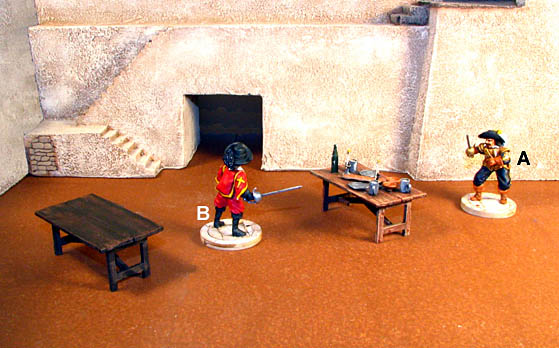 Musketeer A (Rating 3) and Guard B (Rating 2) are facing off across the courtyard. A has the initiative. 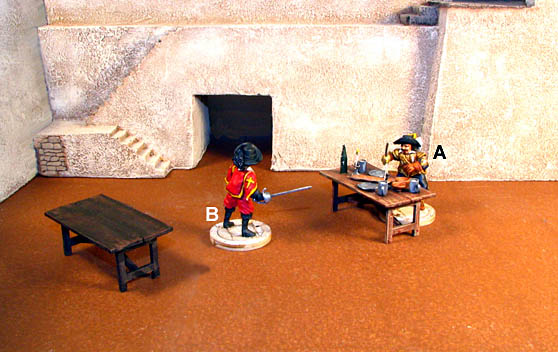
A runs up to the table and must either stop and end his turn, or perform an action (movement is not an action; an action is interacting with an object). For his first action A throws a tankard at B. Because it is A's first action he rolls one dice. B rolls his Rating dice (two dice) to avoid the flying tankard. A rolls a '4' and B rolls a '2' & '3'. A's '4' beats B's highest dice,'3', so B takes one hit from the tankard (4 minus 3 equals 1). On the Swashbuckling Hits Table a single hit is a "Pushed Back" result. 
As a result of the hit B is pushed directly back against the table. A still has the initiative because he didn't roll a '1'.
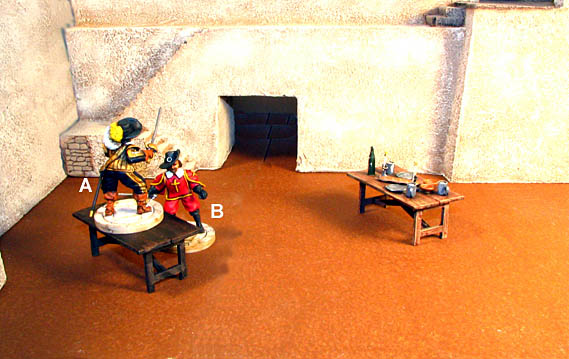
A leaps over the first table. This is A's second action, so he rolls two dice. He still doesn't roll a '1', so still has the initiative.
A runs up to the table beside B and leaps onto it. Leaping onto the table is A's third action, so he rolls three dice. No '1' yet, so he continues. A now decides to duel B. A has three swashbuckling dice, because he performed three actions prior to the duel. For the duel A rolls a total of seven dice - his three swashbuckling dice + his three Rating dice + one bonus dice for his elevation advantage. B rolls his two Rating dice. A rolls 1, 3, 3, 3, 4, 4 & 5. B rolls 3 & 3. A's highest dice is a '5', B's highest dice is a '3'. B takes two hits, which are a "Pushed Back" and "Wounded" result on the Duelling Hits Table. 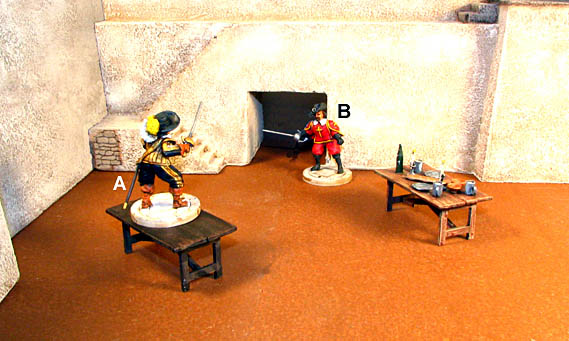
The first hit pushes B back away from A until he reaches the wall. The second hit causes a wound.
Because A rolled a '1' in the duel, he loses the initiative. His turn ends and it is now the Guard's turn. If A hadn't rolled a '1', he could continue his turn - he could either run up to B and duel him again, or perform further actions. Sequence B 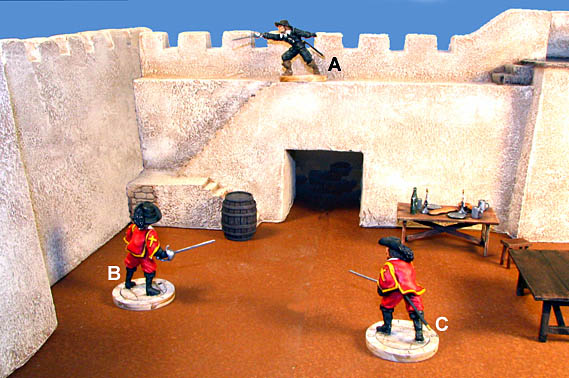
Musketeer A (Rating 3) is on the battlements and has the initiative. Guards B and C (Rating 2) await him below!
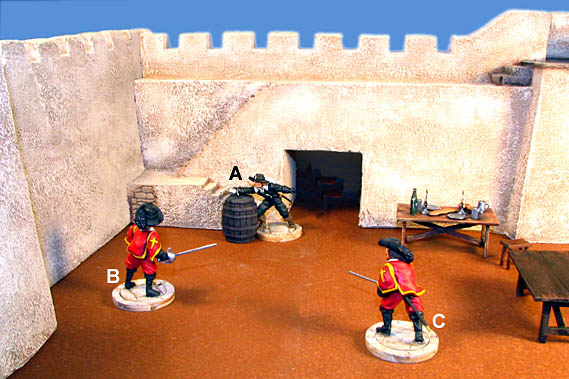
A bounds down the first flight of stairs as his first action, then down the second flight of stairs to the barrel as his second action. Movement in itself is not an action, but because A is interacting with an object on the playing area (i.e. the stairs), then each flight of stairs counts as an action.
A rolls one dice after the first flight and doesn't roll a '1', rolls two dice after the second flight, still doesn't roll a '1', and reaches the barrel. 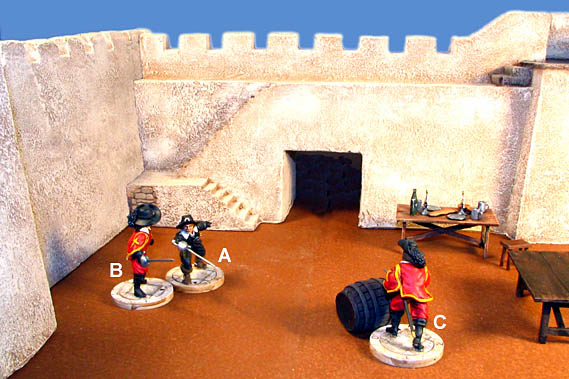
As his third action A rolls the barrel at C, so rolls three dice and gets '4,4 & 5'. C rolls his two Rating dice to avoid the barrel and gets '2' &'6'. C's highest dice is '6', which beats A's highest dice of '5', so C has just managed to avoid being hit by the barrel!
A then rushes B and slaps him in the face as his fourth action, rolling four dice and getting '2, 2, 3 & 4'. B rolls his two Rating dice and rolls '1'& '5'. B's 5 beats A's 4, so B suffers no hits from the blow, only some humiliation! A has still not rolled a '1', so may continue his turn. 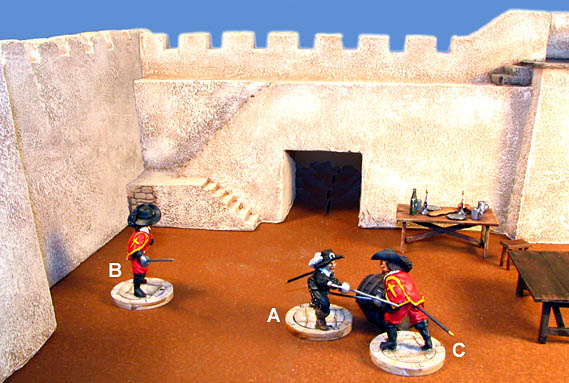
A charges in to duel C. A rolls seven dice for the duel - four swashbuckling dice (because he has performed four actions) + three Rating dice. C rolls his two Rating dice.
A rolls 1, 2, 2, 4, 4, 4 & 6, but C rolls two '6's! Each extra '6' in a roll adds one to the first '6' - so C has rolled a '7'. A takes one hit, which on the Duelling Hits Table is a "Pushed Back" result. 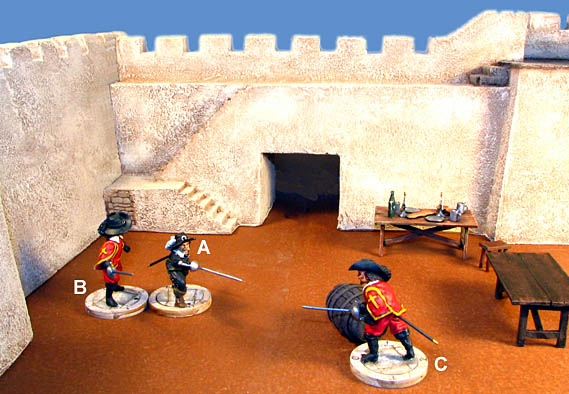
A is pushed back as a result of the hit. The two players decide that A is pushed back against B as a result of moving directly backwards. A also rolled a '1' so has lost the initiative. It is now the Guards' player's turn to win back some honour!
Sequence C
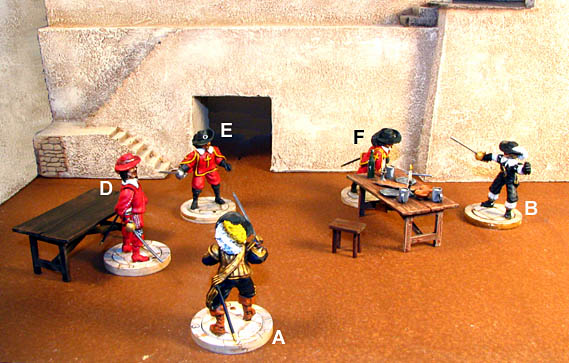
Two musketeers (A & B) are facing off against three guards (D, E & F). The musketeers have the initiative.
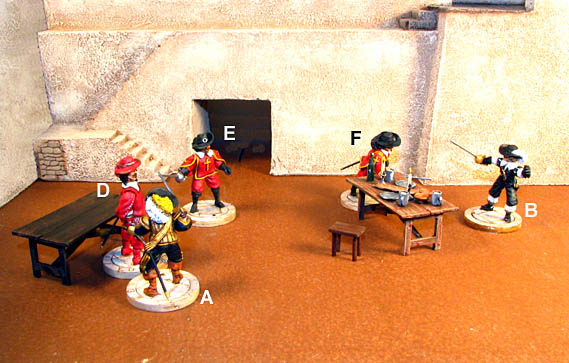
A moves into base contact with D, but opts not to perform an action or duel, so his turn immediately ends.
The Musketeer player still has the initiative however and can move B. 
B wants to get to the stool and throw it at someone!
On the way he runs up to F and kicks him in the kneecap. This is B's first action so he rolls one dice and gets a '3'. F tries to avoid the kick by rolling his two rating dice, and rolls '3' & '4'. His '4' is higher than B's '3', so F successfully avoids the impact of the kick. B didn't roll a '1' so still has the initiative. B dodges F as his second action and then rolls two dice. Dodging another figure is not an opposed roll, so B is simply rolling to see if he still has the initiative. He does, and runs to the stool. 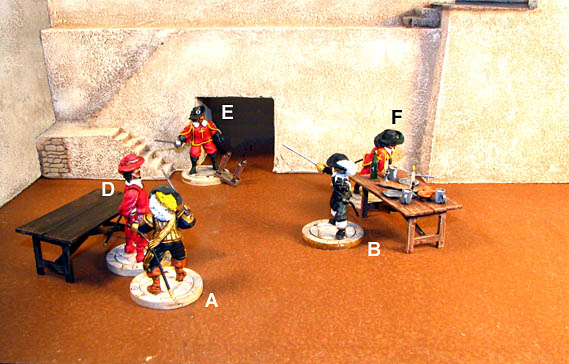
B throws the stool at E as his third action. He rolls three dice and gets '3','5', & '5'. E rolls his two Rating dice getting '1' & '3'. B's highest dice '5' beats E's highest dice '3' and the stool inflicts two hits on E. Two hits on the Swashbuckling Hits table means that E is pushed back against the wall and stunned! B didn't roll a '1', so may continue.

B now closes with D and duels, rolling seven dice - three Swashbuckling dice + three for his rating, + a bonus dice for A's support. D rolls his two Rating dice. B rolls '1','1', '3', '3', '4', 5 & 6. D rolls '3' & '4'. B's 6 beats D's '4', causing two hits on D.
On the Duelling Hits Table two hits should be a push back and a wound. But D is already backed against the table so cannot be pushed back. So his hits are moved up one level on the Duelling Hits Table, so his first hit now becomes a "Wounded" and his second hit becomes a "Dropped Weapon". B rolled a '1' in his duel, so loses the initiative. The Musketeers' turn ends and it is now the Guards' turn. |



